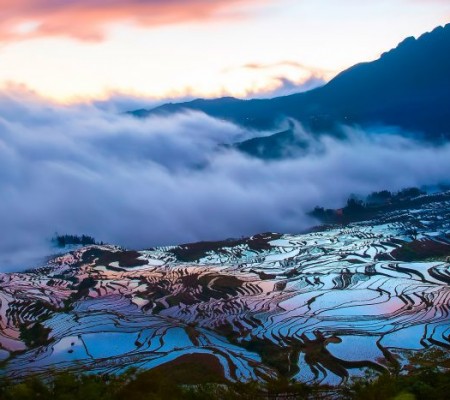
Shangcun Village of Qihe Town in Gucheng District, Lijiang
Geographical Location
Xinmin Shangcun (上村) is located in Quhe Town, Gucheng District, Lijiang City, and is part of the Xinmin Village Committee, situated in the plain area. It is only 0.6 kilometers away from the Xinmin Village Committee and 12 kilometers from Quhe Town, with an altitude of 2201.67 meters and an annual average temperature of 16℃. This mild climate is suitable for growing crops such as rice, barley, and fava beans. The village is surrounded by mountains, with flat and open terrain in the center, and is traversed by water systems like the Yanggong River, which not only provides convenience for agricultural irrigation but also creates beautiful natural landscapes. With its advantageous geographical location, it can be conveniently reached from Lijiang city center by car or public transport, making it an ideal choice for a trip around Lijiang.
Ethnic Groups and Traditional Skills
Xinmin Shangcun is home to multiple ethnic groups, including Han, Naxi, Bai, Yi, Tibetan, Lisu, etc., with a high proportion of ethnic minorities. These ethnic groups live harmoniously together, jointly inheriting and developing a variety of traditional skills.
Naxi Dongba Paper – making (纳西族东巴纸制作技艺)
The Naxi people, one of the main ethnic minorities in Lijiang, are renowned for their Dongba paper – making skills. Dongba paper is made from the local endemic Daphne genus plant, Daphne lichiangensis, and goes through complex processes such as collection, drying, soaking, boiling, washing, pounding, paper – pouring, paper – sticking, and paper – drying. It is strong and mothproof, serving as an important carrier for the inheritance of Dongba culture and often used for writing Dongba scriptures and drawing Dongba paintings. Although only a limited number of people in Shangcun are engaged in this craft, the process of making Dongba paper can still be seen in some local folk activities and cultural heritage sites.
Bai Batik (白族扎染技艺)
The traditional Bai batik skill is also inherited here. Villagers fold, tie, and sew the fabric, then dye it in a dye solution made from natural plants such as indigo. After removing the binding threads, various irregular yet artistic patterns appear on the fabric, such as flowers, birds, fish, insects, and geometric shapes. Batik products are not only beautiful but also have a unique cultural charm and are often used to make clothing, handkerchiefs, tablecloths, etc.
Woodcarving (木雕技艺)
Woodcarving is a skill jointly inherited by multiple ethnic groups. Craftsmen select high – quality wood, such as azalea wood and walnut wood, and carve exquisite patterns on it with superb skills. These patterns cover a wide range of themes, including myths and legends, historical stories, and natural scenery. Woodcarving works are not only used for architectural decoration, such as doors and windows and beams, but also made into various handicrafts, such as woodcarving ornaments and pendants. The carving style is rough but delicate, with a strong ethnic flavor.
Customs and Festivals
The coexistence of multiple ethnic groups makes the customs and festivals in Xinmin Shangcun rich and diverse.
Daily Customs
-
Dietary Customs (饮食习俗): The villagers’ diet integrates the characteristics of various ethnic groups. In addition to common rice and noodles, Naxi dishes such as smoked pork ribs and baba, Bai dishes such as Three – Course Tea and raw pork, and Yi dishes such as Toto Meat are also often seen on the villagers’ tables. Different ethnic groups have their own rules in food preparation and dining etiquette. For example, the Naxi people respect the elderly and honor their elders during meals. Elders start eating first, and then the younger ones can begin.
-
Living Customs (居住习俗): Influenced by the traditional architectural styles of various ethnic groups, the houses in the village include both Naxi – style “Three Rooms and One Screen Wall” and “Four – Courtyard and Five Sky – wells” earth – wood – structure houses and Bai – style buildings with blue tiles, white walls, and upturned eaves. The layout of the houses focuses on harmony with the natural environment, with flowers and fruit trees planted in the courtyards to create a comfortable living environment.
Important Festivals
-
Sanduo Festival (三朵节): On the eighth day of the second lunar month every year, the Naxi people celebrate the Sanduo Festival, a grand festival to worship their ethnic protector god “Sanduo”. Naxi villagers in Shangcun dress in their finest clothes and go to the nearby Sanduo Temple to offer sacrifices, praying for favorable weather, abundant harvests, and prosperity of livestock. After the sacrifice, everyone gathers together to hold a grand song and dance event, performing traditional dances such as Ali Li and Dajiao.
-
Torch Festival (火把节): On the twenty – fourth day of the sixth lunar month, the Yi, Bai, and other ethnic groups jointly celebrate the Torch Festival. On that evening, every household sets up a tall torch in front of their door, made of pine torches and firewood, and decorated with colorful flags. As night falls, the torches are lit. Villagers hold small torches and parade around the big torch, chanting blessings. Subsequently, a grand bonfire party is held, with people singing and dancing around the bonfire, creating a spectacular scene.
-
March Street (三月街): Originally a grand festival and market of the Bai people, March Street is now participated in by all ethnic groups in Shangcun and the surrounding areas. From the fifteenth to the twenty – first day of the third lunar month every year, people dress in their ethnic costumes and gather together. During this period, there are not only large – scale material exchange activities but also sports and cultural activities such as horse racing, dragon boat racing, and song and dance performances, creating a lively atmosphere.
Ancient Architecture
Kuixing Pavilion (魁星阁)
Located in Xinmin Shangcun, Kuixing Pavilion is a key cultural relic protection unit in Gucheng District. According to research, it was originally built in the year of Daoguang Bingwu. At that time, due to the annual flooding of the Qinghe River, which severely affected the lives of the people, the villagers spontaneously donated money to build the Kuixing Pavilion by the Qinghe River, hoping to suppress the water demon and protect the local safety. The Kuixing Pavilion is designed as a two – story open – air building with upturned eaves at the four corners, carved dragons and painted phoenixes, and lifelike interior decorations. The upper floor has a statue of Kuixing sitting, facing the Qinghe River, stepping on a turtle head, holding a writing brush, and staring angrily; the lower floor has a statue of the God of Wealth sitting, wearing armor, sitting on a tiger – riding, holding a sword, stepping on a treasure bowl, with a background of a bright red sun and floating auspicious clouds. The pavilion is also embedded with plaques and calligraphy and paintings, and a couplet is written on the main pillar. The whole pavilion looks simple and elegant. In front of the pavilion, there are valuable tree species such as osmanthus and crape myrtle. Next to the pavilion, there is a Horse King Temple, and opposite to it is a stage building. The whole courtyard is built according to the standard of “Three Rooms and One Screen Wall”, which was a landmark architectural courtyard at that time. In April 2006, the People’s Government of Gucheng District listed it as a key cultural relic protection unit and allocated special funds for protection. In accordance with the principle of “restoring the old as it is”, the Kuixing Pavilion was restored in 2007.
Traditional Residences (传统民居)
The village preserves a large number of traditional residences, integrating the architectural styles of the Naxi, Bai, and other ethnic groups. Naxi traditional residences are mostly earth – wood – structure houses, with a layout of “Three Rooms and One Screen Wall” or “Four – Courtyard and Five Sky – wells”. “Three Rooms and One Screen Wall” is composed of the main room, two side rooms, and a screen wall. The screen wall is usually built with bricks and stones and is decorated with beautiful patterns of landscapes and flowers and birds, which are both beautiful and functional for wind – blocking and lighting. The main room is tall and spacious, facing north to south, and serves as the center of family activities, while the side rooms are used for living or storing items. Bai residences are mainly characterized by blue tiles and white walls. The buildings have an elegant appearance, with upturned eaves and exquisite decorations. The doors, windows, and walls are adorned with exquisite woodcarvings, stone carvings, and color paintings, with a wide range of themes such as myths and legends, historical stories, and flowers and birds. These decorations show the Bai people’s superb architectural skills and aesthetic taste.
Tourism Resources
Natural Scenery
-
Rural Landscape : Xinmin Shangcun is surrounded by vast and fertile farmlands with different scenery in each season. In spring, the fields are full of tender green wheat seedlings and fava bean seedlings, full of vitality. In summer, the golden rapeseed flowers and plump rice panicles sway in the wind, showing the hope of harvest. In autumn, the rice fields are fragrant with a golden ocean. In winter, although the farmland looks a bit desolate, the distant mountains and the farmland form a quiet ink – wash painting. Visitors can walk in the fields, participate in agricultural activities, and experience the fun of rural life.
-
River Scenery : Rivers such as the Yanggong River flow through the village. The river water is clear to the bottom, with willows hanging on both banks. Walking along the riverbank, you can enjoy the beautiful water scenery and see villagers washing clothes and vegetables by the river. In summer, when the river water is abundant, it is a good place to cool off. Visitors can play in the shallow water, but safety should be noted.
Cultural Scenery
-
Cultural Experience (民族文化体验): Visitors can delve into the homes of different ethnic groups to experience their daily lives. Learn traditional handicrafts such as Dongba paper – making, batik, and woodcarving, taste ethnic – specific cuisine, and feel the unique atmosphere of harmonious coexistence of multiple ethnic groups. The village also regularly holds cultural activities such as ethnic song and dance performances and traditional handicraft displays, in which visitors can actively participate to gain a deeper understanding of the local culture.
-
Kuixing Pavilion and Traditional Residences Tour (魁星阁及传统民居游览): Visit the Kuixing Pavilion, a key cultural relic protection unit in Gucheng District, to feel its profound historical and cultural connotations and learn about its background story. Stroll around the village to admire the beauty of traditional residences and experience the integration of different ethnic architectural styles. Some residences have been transformed into folk museums or guesthouses, where visitors can stay and experience a combination of tradition and modernity.
Leisure and Entertainment
-
Picking Experience : The fruit – growing industry in Quhe Town is well – developed, and there are many orchards around Xinmin Shangcun. During the fruit – ripening season, visitors can go to the orchards to participate in picking activities. They can pick fresh pears, yellow – skin pears, kiwifruit, strawberries, and other fruits by themselves, taste the sweetness of nature’s gifts, and experience the joy of harvest. Some orchards also offer farmhouse services, where visitors can enjoy the tranquility and comfort of the countryside while tasting farmhouse dishes.
-
Guesthouse Leisure : With the development of rural tourism, a number of characteristic guesthouses have emerged around Xinmin Shangcun. These guesthouses are mostly transformed from traditional residences, preserving the ethnic architectural style while being equipped with modern facilities. Visitors can relax in the guesthouse courtyard, drink tea, and enjoy the sunshine. They can also communicate with the guesthouse owners to learn about the local customs. Some guesthouses also offer special experience activities such as handicraft making and agricultural activities, making the trip more colorful.

 7 Days GolfingTour
7 Days GolfingTour
 8 Days Group Tour
8 Days Group Tour
 8 Days Yunnan Tour
8 Days Yunnan Tour
 7 Days Shangri La Hiking
7 Days Shangri La Hiking
 11 Days Yunnan Tour
11 Days Yunnan Tour
 6 Days Yuanyang Terraces
6 Days Yuanyang Terraces
 11 Days Yunnan Tour
11 Days Yunnan Tour
 8 Days South Yunnan
8 Days South Yunnan
 7 Days Tea Tour
7 Days Tea Tour
 8 Days Muslim Tour
8 Days Muslim Tour
 12 Days Self-Driving
12 Days Self-Driving
 4 Days Haba Climbing
4 Days Haba Climbing
 Tiger Leaping Gorge
Tiger Leaping Gorge
 Stone Forest
Stone Forest
 Yunnan-Tibet
Yunnan-Tibet
 Hani Rice Terraces
Hani Rice Terraces
 Kunming
Kunming
 Lijiang
Lijiang
 Shangri-la
Shangri-la
 Dali
Dali
 XishuangBanna
XishuangBanna
 Honghe
Honghe
 Kunming
Kunming
 Lijiang
Lijiang
 Shangri-la
Shangri-la
 Yuanyang Rice Terraces
Yuanyang Rice Terraces
 Nujiang
Nujiang
 XishuangBanna
XishuangBanna
 Spring City Golf
Spring City Golf
 Snow Mountain Golf
Snow Mountain Golf
 Stone Mountain Golf
Stone Mountain Golf




